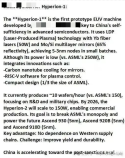Advanced EUV Pilot lines for EUV Metal Organic Photoresist.
According to the Wuxi government website, the 2025 Integrated Circuit (Wuxi) Innovation and Development Conference opened on September 4.
Several major projects were announced at this conference. In addition to the computing power platform, there are two other projects worth noting - the Wuxi Advanced Process Semiconductor Nanoscale Photoresist Pilot Line is the first innovative platform in the country to master the core raw materials, formulas and application technologies of MOR-type photoresist. The photoresist it develops and produces will be world-class.
The other is the Jiangsu (Jicui) Photoresist Resin Synthesis Pilot Line, which is the only R&D platform in the country that uses continuous flow technology to prepare photoresist resins. It is the first polymerization equipment and process for the stable synthesis of polymers.
Among them, MOR photoresist is a new technology for photoresist in the EUV era. It refers to metal oxide photoresist, which replaces the CAR chemical amplification photoresist currently used in DUV photoresist. It is one of the key materials for improving photolithography resolution, reducing gate pitch, and reducing defect rate.

